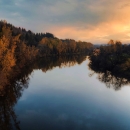About Us
Franz Lake National Wildlife Refuge is the largest and most intact wapato and rush marsh remaining on the lower Columbia River and was established in 1990 to preserve biodiversity. Franz and Arthur lakes provide critical habitat for wintering tundra swans and other waterfowl. Several springs and seeps on the refuge have been identified as important brood and rearing areas for juvenile salmon.
Staff and partners work to maintain and monitor these rare wetland and forested habitats. Knowledge gained through this research will contribute to the understanding to how the lower Columbia River floodplain can be managed. In keeping with this research and monitoring emphasis, human disturbance is kept to a minimum.
Our Mission
The mission of the National Wildlife Refuge System is to administer a national network of lands and waters for the conservation, management and, where appropriate, restoration of the fish, wildlife and plant resources and their habitats within the United States for the benefit of present and future generations of Americans.
Franz Lake National Wildlife Refuge Vision
Franz Lake Refuge is the largest and most intact wapato, spikerush and bulrush marsh remaining on the lower Columbia River. Dynamic riverine processes will continue to be the dominant force shaping the wetlands. Management practices will be directed at maintaining and monitoring these processes. Knowledge gained through research and monitoring will contribute to our understanding of how the lower Columbia River floodplain can be managed to protect, restore and enhance native habitats and species. In keeping with this research and monitoring emphasis, human disturbances will be held to a minimum. The Refuge will, however, provide unique opportunities to observe and learn about its valuable resources from designated viewing sites. (CCP CH1, 1-18)
Other Facilities in this Complex
The Ridgefield National Wildlife Refuge Complex is comprised of four refuges along the lower Columbia River.



